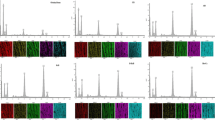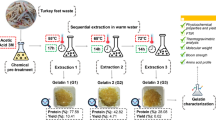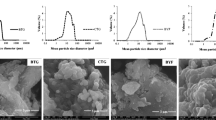Abstract
In this study, gelatin from camel bones (Camelus dromedarius) at three different ages (2.5, 4.5 and 7 years old) was extracted using heating and chemical pretreatment methods. The extraction process was conducted by using hydrochloric acid (0.5 M) (at room temperature 25°c for 72 h) to demineralize the bones and partially hydrolyze the collagen followed by neutralizing with 4% ammonium sulphate. Extraction of camel bone gelatin (CBG) was carried out with distilled water (1:3, w/v) at 75 °C for 3 h, followed by extraction temperature at 90 °C for 1 h resulting in a yield of dry bases ranging from 21.3 to 23.9%. Camel bone gelatin had high protein content (89.31–93.3%), optimum moisture (6.0%), and low ash content (3.62%). The rheological properties, ATR-FTIR and bloom gel, were also investigated. The gel strength (GS) of the camel bone gelatin ranged from 107 to 192 g. The gelatin produced showed good quality and did not differ from other commercial gelatins. The produced gelatin could be useful for food and pharmaceutical implementation.



Similar content being viewed by others

Change history
06 July 2021
A Correction to this paper has been published: https://doi.org/10.1007/s11694-021-01047-w
References
Y.-H. Kuan, A.M. Nafchi, N. Huda, F. Ariffin, A.A. Karim, Effects of sugars on the gelation kinetics and texture of duck feet gelatin. Food Hydrocolloids 58, 267–275 (2016). https://doi.org/10.1016/j.foodhyd.2016.02.025
R. Hashemi Tabatabaei, S.M. Jafari, H. Mirzaei, A. Mohammadi Nafchi, D. Dehnad, Preparation and characterization of nano-SiO2 reinforced gelatin-k-carrageenan biocomposites. Int. J. Biol. Macromol. 111, 1091–1099 (2018). https://doi.org/10.1016/j.ijbiomac.2018.01.116
A. Tügen, B. Ocak, Ö. Özdestan-Ocak, Development of gelatin/chitosan film incorporated with lemon essential oil with antioxidant properties. J. Food Meas. Charact. 14(6), 3010–3019 (2020). https://doi.org/10.1007/s11694-020-00547-5
J. Pan, H. Lian, M. Shang, W. Jin, R. Hao, Y. Ning et al., Physicochemical properties of Chinese giant salamander (Andrias davidianus) skin gelatin as affected by extraction temperature and in comparison with fish and bovine gelatin. J. Food Meas. Charact. 14(5), 2656–2666 (2020). https://doi.org/10.1007/s11694-020-00512-2
E. Ali, S. Sultana, S.B.A. Hamid, M. Hossain, W.A. Yehya, A. Kader et al., Gelatin controversies in food, pharmaceuticals, and personal care products: authentication methods, current status, and future challenges. Crit. Rev. Food Sci. Nutr. 58(9), 1495–1511 (2018). https://doi.org/10.1080/10408398.2016.1264361
A. Abedinia, A.M. Nafchi, M. Sharifi, P. Ghalambor, N. Oladzadabbasabadi, F. Ariffin et al., Poultry gelatin: characteristics, developments, challenges, and future outlooks as a sustainable alternative for mammalian gelatin. Trends Food Sci. Technol. 104, 14–26 (2020)
N. Zhang, H. Liu, L. Yu, X. Liu, L. Zhang, L. Chen et al., Developing gelatin–starch blends for use as capsule materials. Carbohyd. Polym. 92(1), 455–461 (2013). https://doi.org/10.1016/j.carbpol.2012.09.048
A. Abedinia, F. Ariffin, N. Huda, A.M. Nafchi, Preparation and characterization of a novel biocomposite based on duck feet gelatin as alternative to bovine gelatin. Int. J. Biol. Macromol. 109, 855–862 (2018)
A.A. Al-Hassan, Gelatin from camel skins: extraction and characterizations. Food Hydrocolloids 101, 105457 (2020). https://doi.org/10.1016/j.foodhyd.2019.105457
A. Abedinia, F. Ariffin, N. Huda, A.M. Nafchi, Extraction and characterization of gelatin from the feet of Pekin duck (Anas platyrhynchos domestica) as affected by acid, alkaline, and enzyme pretreatment. Int. J. Biol. Macromol. 98, 586–594 (2017)
M. Alshafiee, M.K. Aljammal, D. Markl, A. Ward, K. Walton, L. Blunt et al., Hot-melt extrusion process impact on polymer choice of glyburide solid dispersions: the effect of wettability and dissolution. Int. J. Pharm. 559, 245–254 (2019). https://doi.org/10.1016/j.ijpharm.2019.01.038
M.C. Gómez-Guillén, J. Turnay, M.D. Fernández-Dı́az, N. Ulmo, M.A. Lizarbe, P. Montero, Structural and physical properties of gelatin extracted from different marine species: a comparative study. Food Hydrocolloids 16(1), 25–34 (2002). https://doi.org/10.1016/S0268-005X(01)00035-2
I.J. Haug, K.I. Draget, O. Smidsrød, Physical and rheological properties of fish gelatin compared to mammalian gelatin. Food Hydrocolloids 18(2), 203–213 (2004). https://doi.org/10.1016/S0268-005X(03)00065-1
M.H. Norziah, A. Al-Hassan, A.B. Khairulnizam, M.N. Mordi, M. Norita, Characterization of fish gelatin from surimi processing wastes: thermal analysis and effect of transglutaminase on gel properties. Food Hydrocolloids 23(6), 1610–1616 (2009). https://doi.org/10.1016/j.foodhyd.2008.12.004
M. Ahmad, S. Benjakul, Characteristics of gelatin from the skin of unicorn leatherjacket (Aluterus monoceros) as influenced by acid pretreatment and extraction time. Food Hydrocolloids 25(3), 381–388 (2011). https://doi.org/10.1016/j.foodhyd.2010.07.004
D. Fernández, P. Montero, M.C. Gómez-Guillén, Effect of freezing fish skins on molecular and rheological properties of extracted gelatin. Food Hydrocolloids 17(3), 281–286 (2003). https://doi.org/10.1016/S0268-005X(02)00078-4
M.C. Gómez-Guillén, B. Giménez, M.E. López-Caballero, M.P. Montero, Functional and bioactive properties of collagen and gelatin from alternative sources: a review. Food Hydrocolloids 25(8), 1813–1827 (2011). https://doi.org/10.1016/j.foodhyd.2011.02.007
A. Ishaq, U. Rahman, A. Sahar, R. Perveen, A.J. Deering, A.A. Khalil et al., Potentiality of analytical approaches to determine gelatin authenticity in food systems: a review. LWT 121, 108968 (2020). https://doi.org/10.1016/j.lwt.2019.108968
X.-M. Sha, Z.-C. Tu, W. Liu, H. Wang, Y. Shi, T. Huang et al., Effect of ammonium sulfate fractional precipitation on gel strength and characteristics of gelatin from bighead carp (Hypophthalmichthys nobilis) scale. Food Hydrocolloids 36, 173–180 (2014). https://doi.org/10.1016/j.foodhyd.2013.09.024
N.A. Nik Muhammad, N. Huda, A.A. Karim, N.A. Mohammadi, Effects of acid type extraction on characterization and sensory profile of duck feet gelatin: towards finding bovine gelatin alternative. J. Food Meas. Charact. 12(1), 480–486 (2018). https://doi.org/10.1007/s11694-017-9661-8
M.A.A. Abri, B. Faye, Genetic improvement in dromedary camels: challenges and opportunities. Front. Genet. (2019). https://doi.org/10.3389/fgene.2019.00167
MEWA. Ministry of Enviroment Water and Agriculture, Animal Population Members (MEWA, Riyadh, 2017)
O.K. Yousif, S.A. Babiker, The desert camel as a meat animal. Meat Sci. 26(4), 245–254 (1989). https://doi.org/10.1016/0309-1740(89)90010-7
H.A. Al-Kahtani, I. Jaswir, E.A. Ismail, M.A. Ahmed, A. Monsur Hammed, S. Olorunnisola et al., Structural characteristics of camel-bone gelatin by demineralization and extraction. Int. J. Food Prop. 20(11), 2559–2568 (2017). https://doi.org/10.1080/10942912.2016.1244543
V. Ferraro, B. Gaillard-Martinie, T. Sayd, C. Chambon, M. Anton, V. Santé-Lhoutellier, Collagen type I from bovine bone. Effect of animal age, bone anatomy and drying methodology on extraction yield, self-assembly, thermal behaviour and electrokinetic potential. Int. J. Biol. Macromol. 97, 55–66 (2017). https://doi.org/10.1016/j.ijbiomac.2016.12.068
B.S. Institution, Methods for Sampling and Testing Gelatine (Physical and Chemical Methods) (British Standards Institution, London, 1975)
J.A. White, R.J. Hart, J.C. Fry, An evaluation of the waters pico-tag system for the amino-acid analysis of food materials. J. Autom. Chem. 8, 867320 (1986). https://doi.org/10.1155/S1463924686000330
J.H. Muyonga, C.G.B. Cole, K.G. Duodu, Fourier transform infrared (FTIR) spectroscopic study of acid soluble collagen and gelatin from skins and bones of young and adult Nile perch (Lates niloticus). Food Chem. 86(3), 325–332 (2004). https://doi.org/10.1016/j.foodchem.2003.09.038
I. Ratnasari, S. Yuwono, H. Nusyam, S. Widjanarko, Extraction and characterization of gelatin from different fresh water fishes as alternative sources of gelatin. Int. Food Res. J. 20(6), 3085 (2013)
Gmia, Gelatin Handbook (Gmia Inc, New York, 2012)
K. Shyni, G.S. Hema, G. Ninan, S. Mathew, C.G. Joshy, P.T. Lakshmanan, Isolation and characterization of gelatin from the skins of skipjack tuna (Katsuwonus pelamis), dog shark (Scoliodon sorrakowah), and rohu (Labeo rohita). Food Hydrocolloids 39, 68–76 (2014). https://doi.org/10.1016/j.foodhyd.2013.12.008
B. Jamilah, K.G. Harvinder, Properties of gelatins from skins of fish—black tilapia (Oreochromis mossambicus) and red tilapia (Oreochromis nilotica). Food Chem. 77(1), 81–84 (2002). https://doi.org/10.1016/S0308-8146(01)00328-4
J.S. Zilhadia, H. Yahdiana, J. Irwandi, A. Effionora, Characterization and functional properties of gelatin extracted from goatskin. Int. Food Res. J. 25(1), 275–281 (2018)
R.S.G. Silva, S.F. Bandeira, L.A.A. Pinto, Characteristics and chemical composition of skins gelatin from cobia (Rachycentron canadum). LWT Food Sci. Technol. 57(2), 580–585 (2014). https://doi.org/10.1016/j.lwt.2014.02.026
A. Jongjareonrak, S. Rawdkuen, M. Chaijan, S. Benjakul, K. Osako, M. Tanaka, Chemical compositions and characterisation of skin gelatin from farmed giant catfish (Pangasianodon gigas). LWT Food Sci. Technol. 43(1), 161–165 (2010). https://doi.org/10.1016/j.lwt.2009.06.012
H. Yang, Y. Wang, P. Zhou, J.M. Regenstein, Effects of alkaline and acid pretreatment on the physical properties and nanostructures of the gelatin from channel catfish skins. Food Hydrocolloids 22(8), 1541–1550 (2008). https://doi.org/10.1016/j.foodhyd.2007.10.007
A. Sanaei, F. Mahmoodani, S. See, S. Yusop, A. Babji, Optimization of gelatin extraction and physico-chemical properties of catfish (Clarias gariepinus) bone gelatin. Int. Food Res. J. 20(1), 423 (2013)
V. Gudipati, Fish gelatin: a versatile ingredient for the food and pharmaceutical industries, in Marine Proteins and Peptides. ed. by S.K. Kim (Wiley, Chichester, 2013), pp. 271–295
N.F. Mohtar, C. Perera, S.-Y. Quek, Optimisation of gelatine extraction from hoki (Macruronus novaezelandiae) skins and measurement of gel strength and SDS–PAGE. Food Chem. 122(1), 307–313 (2010). https://doi.org/10.1016/j.foodchem.2010.02.027
G. Boran, S.J. Mulvaney, J.M. Regenstein, Rheological properties of gelatin from silver carp skin compared to commercially available gelatins from different sources. J. Food Sci. 75(8), E565–E571 (2010). https://doi.org/10.1111/j.1750-3841.2010.01543.x
R. Balti, M. Jridi, A. Sila, N. Souissi, N. Nedjar-Arroume, D. Guillochon et al., Extraction and functional properties of gelatin from the skin of cuttlefish (Sepia officinalis) using smooth hound crude acid protease-aided process. Food Hydrocolloids 25(5), 943–950 (2011). https://doi.org/10.1016/j.foodhyd.2010.09.005
S. Farris, J. Song, Q. Huang, Alternative reaction mechanism for the cross-linking of gelatin with glutaraldehyde. J. Agric. Food Chem. 58(2), 998–1003 (2010). https://doi.org/10.1021/jf9031603
N. Mhd Sarbon, F. Badii, N.K. Howell, Preparation and characterisation of chicken skin gelatin as an alternative to mammalian gelatin. Food Hydrocolloids 30(1), 143–151 (2013). https://doi.org/10.1016/j.foodhyd.2012.05.009
M. Nagarajan, S. Benjakul, T. Prodpran, P. Songtipya, Effects of bleaching on characteristics and gelling property of gelatin from splendid squid (Loligo formosana) skin. Food Hydrocolloids 32(2), 447–452 (2013). https://doi.org/10.1016/j.foodhyd.2013.02.003
W.K. Surewicz, H.H. Mantsch, New insight into protein secondary structure from resolution-enhanced infrared spectra. Biochim. Biophys. Acta (BBA) 952, 115–130 (1988). https://doi.org/10.1016/0167-4838(88)90107-0
V. Pshenitsyna, N. Molotkova, M. Noskova, B.Y. Aksel’Rod, Display of the amide II absorption band in the spectra of reaction products of urea with formaldehyde. J. Appl. Spectrosc. 29(3), 1098–1101 (1978)
Acknowledgements
The author would like to express his thanks to King Abdul-Aziz City for Science and Technology (KACST) Saudi Arabia for the financial support under project No: A.T. 34-305.
Author information
Authors and Affiliations
Contributions
AAA Investigation, Conceptualization, Methodology, Validation, Formal analysis, Writing-original draft, Funding. AMN: Software, Data curation, Validation, Supervision, AMA Investigation; FA: Investigation; HMM: Investigation, Resources.
Corresponding authors
Ethics declarations
Conflict of interest
The authors have declared that they have no conflict of interest.
Animal and human rights
This article does not contain any studies with human or animal subjects.
Additional information
Publisher's Note
Springer Nature remains neutral with regard to jurisdictional claims in published maps and institutional affiliations.
The original version of this article, unfortunately, contained a mistake. The second and third author’s affiliations mixed up and the correct affiliations are as follow: A. M. Abdel-Salam Dairy Science Department, National Research Centre, Dokki, Cairo, 12622, Egypt F. Al Nasiri Saudi Food and Drug Administration, Riyadh, 13312, Saudi Arabia Also, the article has two corresponding authors, A. A. Al-Hassan and Abdorreza Mohammadi Nafchi These errors do not affect any results or conclusions. The original article has been corrected.
Rights and permissions
About this article
Cite this article
Al-Hassan, A.A., Abdel-Salam, A.M., Al Nasiri, F. et al. Extraction and characterization of gelatin developed from camel bones. Food Measure 15, 4542–4551 (2021). https://doi.org/10.1007/s11694-021-01029-y
Received:
Accepted:
Published:
Issue Date:
DOI: https://doi.org/10.1007/s11694-021-01029-y



